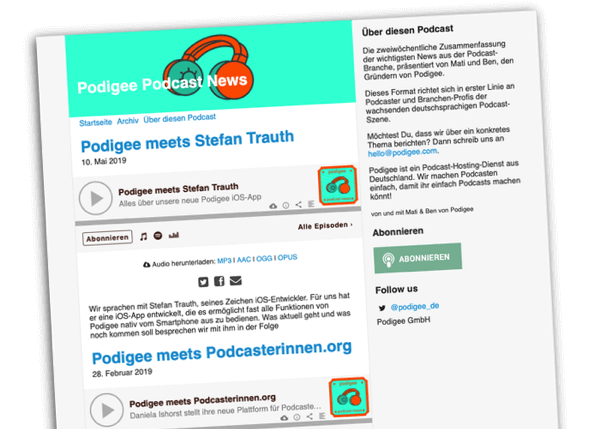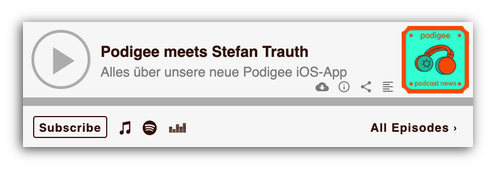Podcasts are a great medium, because the entry hurdle is quite low. But usually you don't make a podcast just for yourself, you want to reach other people with it. Find out how you can increase the number of listeners of your podcast.
I’ve put together 10 tips that improve specific, often overlooked aspects of your podcast setup and have a lasting impact on the number of listeners of your podcast.
All tips at a glance
- Use the podcast info correctly
- Choose the right category
- The perfect cover image
- A podcast needs a home – the podcast website
- The unbeatable duo: Web player and subscribe button
- Use your private network
- Channel Takeovers
- It’s okay to ask for feedback and ratings!
- Pay attention to audio quality
- Publish your podcast regularly and keep on
Attention! This is no how-to-get-rich-fast-solution. In the end, only you can judge what fits your concept and how you want to implement it, but if you follow these tips, you have much better chances to reach your goal.
The tips
1. Using the podcast info correctly
There are many different podcast metadata fields that can be used better or worse by podcasters. Here is a short summary of the most important ones that have an influence on the reach:
- Podcast title: short, crisp, easy to understand
- Podcast description: Why should I listen to the podcast (and not to the others in the same category)? What is there for me? How often are new episodes published?
- Episode title: What is this episode about? One sentence
- Episode summary: Okay, now I’d like to know a little bit more about why I should listen to this.
- Episode description: I made it this far and I’m really interested in this episode. Can you explain to me in a few sentences why it’s worth listening to this again?
- Episode show notes: Shownotes have no direct influence on the decision whether it is worth listening to – but it is a reward for existing listeners, because they can look up what websites / links have been mentioned in the episode.
- Keywords: Keywords allow podcast directories to assign your podcasts to the right category. Unfortunately, they are not used by Apple Podcasts or Spotify.
2. Choose the right category
In directories like Apple Podcasts, you can assign podcasts to one or more categories. Choosing the right category is relevant because there are some categories that are very crowded and others that are not.
For example, if you would start a yoga podcast you might want to choose the less-crowded category “Health” instead of “Sports & Recreation”.
This has a clear advantage with Apple Podcasts, where there are traditionally different pages per category and you simply have a better chance of being featured if you belong to a less populated category.
You can get more insights in this blog post.
3. The perfect cover image
Obviously every podcast always wants to have a cover image that is as beautiful as possible. Beauty is relative of course, but what objectively belongs to a podcast cover is the text. The podcast title should always be part of the cover image. If the podcast is produced by a well-known personality or brand, it is worth mentioning it.
A little tip that works very well: 2-3 keywords that describe the “tone” of the podcast, e.g. “honest, open, funny” when it comes to lifestyle. Or “serious, understandable” for financial podcasts. You get the idea.
What is often discussed: should the term “podcast” appear on the cover when it is already clear that it is a podcast? Well, that depends on where your potential audience mainly finds the podcast – with Apple Podcasts or most podcast apps it’s clear. But if you present the podcast on your website with a web player or on Instagram, Twitter and Facebook then it might be worth to include the term “podcast”.
4. A podcast needs a home – the podcast website

Podcasts are mainly played on platforms and in apps, right? Then why a website?
Well, it might be true that most of the established podcasts are mainly played on platforms (or are predominantly subscribed to – the difference would be beyond the scope here – I’m looking forward to your feedback if you want to know more!).
A podcast needs a home. Whether you take your existing website or use a ready-made solution (Podigee gives you a podcast website for free, for example), it is important that your podcast has its own landing page, with an overview of the episodes and, if possible, a single page per episode. This allows you to direct traffic to specific episodes via social media.
On your podcast website, you should always have a prominent player and a way to subscribe to the podcast as easily as possible (more on this in the next section). Best with a good explanation if your audience isn’t very tech-savvy!
The big mistake that many podcasters make, even if they have a podcast website, is to not offer a decent web player and a subscribe button.
The web player (some also know it as a “plugin” or “audio widget”) allows visitors to play your podcast directly on the website. No app is necessary and the visitors are only one click away from your content.
Now someone has listened to your episode, thinks the content is great and wants more of it. The solution: the subscribe button! The Subscribe button allows visitors to your website to subscribe to your podcast with the podcast app of their choice. And if you don’t know the term “subscribe” in the podcast context: to subscribe to a podcast means to get all new episodes automatically on your smartphone – using a podcast app like Apple Podcasts or (my personal recommendation) PocketCasts. This means that as a listener, I don’t have to go to your website every time to find new content. The content finds me. And as a creator, you have the advantage of building a loyal audience because listeners tend to listen to you rather than a podcast they haven’t subscribed to!

With Podigee, the web player comes with the subscription button as a simple plugin for websites, without you having to do anything extra.
Many podcasters underestimate the importance of this duo, so I definitely recommend that you use it!
6. Use your private network
Oh yes, annoy friends, relatives and co-workers – what a great tip! Look: I know this may seem annoying and you can feel like you’re moving outside your own comfort zone – but it works!
Even if people don’t subscribe directly to your podcast, but know about its existence, there’s always a chance that they will recommend you to other people – even if they don’t listen to it themselves!
And the most important thing: You have to believe in your podcast yourself for others to do the same!
7. Channel Takeovers
A rarity in the field of podcasting, where the interview variant has become more popular in order to increase reach. However, takeovers are an opportunity to offer something new and different to your listeners.
What is a channel takeover anyway? A takeover is when another podcaster takes over your podcast and records an episode. On a professional level, you can also hire influencers – but of course this involves relatively high costs.
Initially I always recommend to search for other podcasters in your environment and offer a take-over exchange. Over time, you can broaden your horizons and bring in podcasters who appeal to completely different audiences in order to reach completely new listeners.
8. It’s okay to ask for feedback and ratings!
A classic, but many don’t do it consistently: It’s okay to ask for reviews and feedback in your podcast! The main thing is that it feels natural and that you thank your listeners for it. What also works: read the feedback since the last episode out loud and thank the people with names! You will collect more reviews and improve your presence on platforms like Apple Podcasts.
9. Pay attention to audio quality
Huh? Audio quality, what should I improve?
Please ignore the typical “wisdom” that says: “Only the content matters”. That’s not true at all! It’s not either good content or good audio – a good podcast needs both! A bicycle cannot be used sensibly without a steering wheel or pedals - you don’t ask yourself which part is more important.
So how can you still improve the audio quality of your recordings today? Of course, a better microphone can help. But as important as the mic is the room in which you record. It shouldn’t have so much reverberation and therefore as few flat surfaces as possible like windows and bare walls. Curtains, carpets and bookshelves are great for acoustics. A little bonus tip: You can find foam sound absorbers starting at 3.50 € per piece online.
And what about existing podcast episodes? You can make improvements afterwards with services that optimize the audio files. With Podigee you get a certain amount of coding hours for each package, which improves the audio quality of your files a lot. Podigee uses Auphonic for that. It’s a professional tool that has established itself as the de facto standard in the German-speaking podcast scene and is also used by many in the U.S.
10. Publish your podcast regularly and keep on
I know the “improve today” thing doesn’t quite fit anymore.
Podcasts live on regular publication. Sure, the beauty of podcasting is that everyone decides for themselves when they want to consume your content. So far it’s true. But the really successful podcasts have one thing in common: they regularly publish new episodes, often on the same day and hour! Content that appears regularly always wins.
What can you still do in this sense today? I recommend that you create an editorial plan. Why don’t you plan what you want to talk about four to six episodes in advance? Fill in the gaps. Sort the order so that the same subjects don’t repeat too often one after the other. Create reminders for yourself. You could also record a few episodes in advance and plan the release (little bonus tip: we offer this for free at Podigee with every plan).
This way you can be sure that you have enough content in case something comes up or you have a somewhat unmotivated phase. Keep working on it! The most popular podcasts are often those that have existed for a long time and produce content on a regular basis.
Well, these were my 10 tips. Did I forget something? If so, let me know on Twitter or Facebook!
Are you looking for a reliable, best-in-class podcast hosting? Podigee offers automatic publishing to Spotify, YouTube and Deezer, audio optimization with Auphonic and an outstanding web player with integrated subscribe button. And we are GDPR compliant. You can check out our plans here!